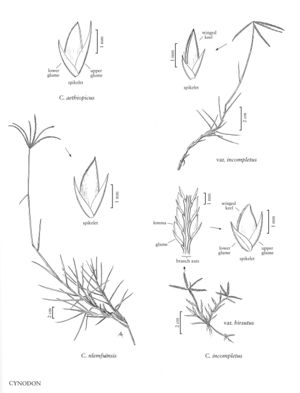Difference between revisions of "Cynodon incompletus"
imported>Volume Importer |
imported>Volume Importer |
||
| (One intermediate revision by the same user not shown) | |||
| Line 37: | Line 37: | ||
|publication year= | |publication year= | ||
|special status= | |special status= | ||
| − | |source xml=https:// | + | |source xml=https://bitbucket.org/aafc-mbb/fna-data-curation/src/200273ad09963decb8fc72550212de541d86569d/coarse_grained_fna_xml/V25/V25_851.xml |
|subfamily=Poaceae subfam. Chloridoideae | |subfamily=Poaceae subfam. Chloridoideae | ||
|tribe=Poaceae tribe Cynodonteae | |tribe=Poaceae tribe Cynodonteae | ||
Latest revision as of 17:59, 11 May 2021
Plants stoloniferous, not rhizomatous. Culms 5-30 cm. Sheaths glabrous; ligules membranous; blades 1.5-6 cm long, 2-4 mm wide, glabrous or pubescent. Panicles with 2-6 branches; branches 2-5 cm, in a single whorl, axes flattened. Spikelets 2-3 mm, narrowly to broadly ovate. Glumes 1.7-2.1 mm, exceeded by the florets; lemmas 2.2-2.6 mm, keels winged and pubescent, mar¬gins glabrous. 2n = 18, 36.
Discussion
Cynodon incompletus is native to southern Africa. A hybrid between the two varieties identified below, Cynodon xbradleyi Stent, is used as a lawn grass in North America (de Wet and Harlan 1970).
1. Blades glabrous or sparsely hirsute; spikelets 2.5-3 mm long, narrowly ovate var. incompletus 1. Blades densely hirsute; spikelets 2-2.5 mm long, broadly ovate var. hirsutus
Selected References
None.
